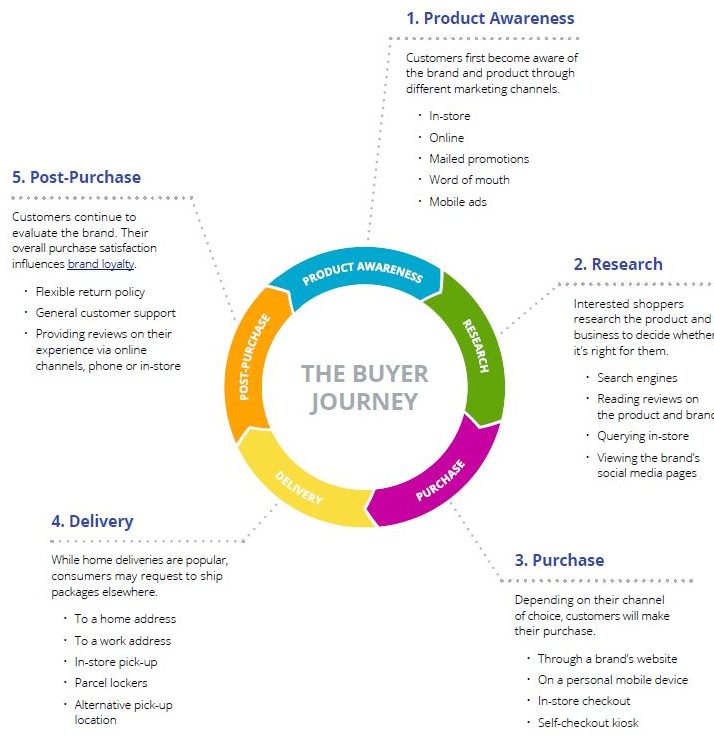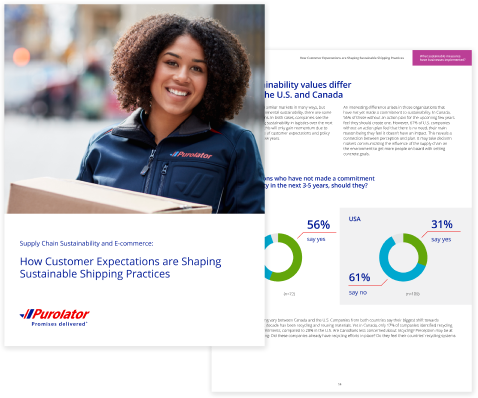Providing a personalized customer experience has become a big selling factor in both B2B and B2C in the last decade or so. Once used to gain a competitive edge, it’s becoming commonplace for businesses to offer their customers an experience that’s tailored to their needs. In fact, 80% of consumers are more likely to make a purchase from a brand that provides personalized experiences, and 94% of U.S. consumers are more likely to purchase from businesses that provide a “very good” customslideer experience. However, a personalized customer experience begins even before a customer makes a purchase. It has to be a consistent part of the buyer’s journey, from data collection at the product awareness stage to customer support at post-purchase. By personalizing every aspect of the buyer’s journey, the chances of a customer making a purchase increases and the positive experience can be a driving incentive for them to make future purchases and creates brand loyalty.
View the 5 ways to create a personalized customer experience throughout the buyer’s journey.
What is a personalized customer experience?
A personalized customer experience is all about tailoring products and services to suit each individual customer. By going above and beyond customer expectations, through identifying and addressing specific needs, businesses can create a lasting impression on the people they serve. Examples include:
- A restaurant that remembers a customer’s favourite table, and recommends drinks that complement their usual order.
- An online store that recommends products based on a customer’s past purchases.
- A car dealership that knows the exact model a customer is looking for, and offers to perform an upgrade based on their personal preferences.
Personalization can create greater customer loyalty and increase wallet share. On top of that, it drives impulse purchases, with 49% of customers buying items they didn’t intend to buy due to personalization. It can even lead to fewer returns, as only 5% of those same impulse purchases led to returns. Despite all its benefits, it does take some additional steps to implement, such as:
- Replacing data silos with an omnichannel strategy: It’s often the case that customers share their data with your business through a variety of online and offline channels. By breaking down the silos of different marketing and sales channels, customers are provided a consistent and seamless experience, regardless of whether they jump from channel-to-channel or person-to-chatbot.
- Creating complete customer personas: Understanding your customers’ needs is vital for any personalization endeavour. Data collection is the first step of creating customer personas, so your business has an idea of what your customers are looking for at any time.
- Making a lasting impression: What makes personalization memorable is when a business goes out of its way to satisfy a customer’s needs. This can be done by offering gestures of goodwill and making customers feel unique with exceptional service.
How do you get started? Here are five ways to create a personalized customer service and experience throughout the buyer’s journey.
Personalize the buyer’s journey
The buyer’s journey is the series of steps that every customer takes from awareness to purchase and beyond. It usually begins with a customer being made aware that they have a problem that requires solving. Through your marketing efforts, they’ll consider your product as a possible solution. The purchase stage, and the stages that follow it, are when a personalized customer experience really helps buyers feel like the product they bought was the right fit for their specific needs.
While personalization is vital near the end of the buyer’s journey, it’s still important to personalize each stage. For example, data collected during awareness can be used to improve customer service at the post-purchase stage, creating a seamless customer experience.
Build an omnichannel strategy
Creating a personalized customer experience requires real data from all channels, such as in-person, e-commerce, applications and social media. That’s what an omnichannel strategy is all about: Creating a consistent and personalized experience that follows the customer throughout all the channels they use to engage with their desired products and services.
Starbucks’ loyalty rewards program is one example of how an omnichannel strategy can be implemented. Rewards program users can add money to their account through the app on their mobile device, the Starbucks’ website or in store. The results are that customers can access the rewards program wherever is most convenient for them, the experience is consistent regardless of the channel they use and their information gets carried over from channel to channel.
People often use more than one channel to complete their purchase. A customer might become aware of a product from an advertisement, purchase it online, visit the store to pick it up in person and then call a customer support line afterwards to ask questions. That’s four different channels of interaction, and 76% of consumers anticipate a consistent experience throughout.
This can only be made possible by using an omnichannel strategy. By leveraging the same customer data, preferences and shopping habits across all channels, each customer’s experience is made seamless, simple and intuitive.
Use customer relationship management (CRM) tools to create a full customer profile
Customer data collection by using CRM tools is a vital part of creating a full customer profile to support the early stages of the buyer’s journey. By having a complete understanding of a target audience’s pain points, marketing products and services that appeal to their needs becomes an easier task. Look for a CRM tool that can be used for all interactions (whether a customer interacts or shops in-store, online or on social media, for example). Common examples of such tools include Salesforce and HubSpot.
Once you’ve found the right CRM tool, here are some tips data gathering tips:
- Segmenting your data by a particular preference or demographic helps to narrow down the focus of your marketing efforts.
- Use this data to target specific shoppers that will be more inclined to complete a sale (or whatever the target outcome is).
- Gathering large amounts of data, and then segmenting it, is an effective way to provide a personalized experience that’s relatable to your audience. The more data you gather about your audiences, the more you can segment your marketing efforts and target their particular needs.
An example of a CRM tool in practice is how Apple ID nurtures their growth strategy. An Apple ID is an account that can access services like the App Store, Apple Music, iCloud, iMessage and FaceTime. These IDs sync across devices, save preferences and make recommendations based on what users engage with. This provides insights on customer preferences for targeted marketing.
Show gestures of goodwill
A gesture of goodwill can impact your customer’s experience in a really beneficial way. Gestures don’t need to cost a lot of money. For example, you can send customers an e-card or a special voucher on their birthday, or even for an anniversary if one was mentioned during an interaction. It can also be used to handle irate customers, or win over unhappy customers from your competitors.
Here are a few examples of goodwill gestures:
- Ben & Jerry’s invites its unhappy customers to tour its facilities for free once their feedback has been implemented. This shows customers that their input matters, and shows the company’s commitment to customer satisfaction.
- Sephora is well known for giving its Beauty Insider members personalized birthday gifts each year. This encourages customers to become members and retains current members while also making them feel special on their birthday.
88% of U.S. marketers saw measurable improvements due to customer experience personalization.
Use feedback to learn how you can do better
The success of a personalization strategy often relies on feedback from your audience. People enjoy providing feedback when they know it will improve their experience. Consider asking them to fill out a short survey, or if you’re interacting with them via phone, email or social, ask them how their experience could have been improved.
Some useful questions to ask include:
- What do you like about our products and/or services?
- What can we do to make purchases a better experience for you?
- Did you easily find what you’re looking for?
Complete the last mile with a personalized delivery
Due to the COVID-19 pandemic and the rise in e-commerce, more people are getting their purchases delivered. This means that it’s more common for customer fulfillment, and the end of the buyer’s journey, to be handled by delivery services rather than employees looking after the stores. A personalized experience should last throughout the whole buyer’s journey, including the last mile of delivery. For example, a great personalized courier service should offer the recipient a customizable and convenient experience. This can include features like tracking visibility, delivery or pickup preferences, remote signature release and next steps for any missed deliveries. Additionally, a great last-mile service experience doesn’t just help your customers, as the right parcel delivery service provider can grow your business, too. To provide a personalized delivery experience, the right delivery provider can offer customizable solutions that are convenient for each individual customer.
Here are some of the personalized features you should require in your delivery process:
- The option to customize delivery preferences, even while their delivery is on its way. In fact, 49% of consumers said they’ve willingly paid more for better or more convenient delivery options.
- Add a preferred drop-off location (e.g. front door, back door, with the concierge) or convenient access points (e.g. parcel lockers, drop boxes, kiosks and quick stop vehicles).
- Add specific information about their location, such as a buzzer code, or supply specific drop-off instructions.
- The option to sign for a package remotely, so they don’t have to be home when certain packages are delivered.
Customized delivery options and flexible returns can improve the post-purchase experience and boost customer loyalty.
Personalization is key throughout the buyer experience
Given the potential impact it can have on customer loyalty, retention and revenue, it makes sense to provide a personalized experience. By personalizing the buyer’s journey with these five tips, including beyond your business outputs such as during the delivery, you’ll be able to create a memorable and engaging experience for your customers.
1. Offer for a fixed discount up to 65% is available for a limited time only to customers who qualify to create a new Purolator business account and for certain shipments only within Canada. Discount is calculated on Purolator’s published list rates, available at purolator.com/rates and cannot be combined with other discounts.



